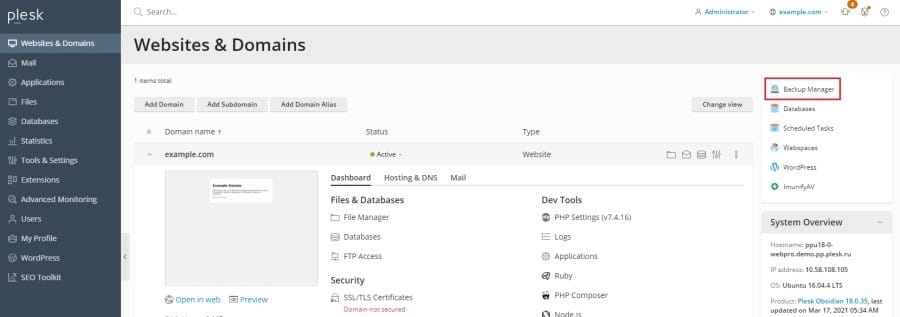In the realm of VPS (Virtual Private Server) hosting, the efficiency and ease of managing your server can significantly impact your online success. Control panels play a pivotal role in this management, acting as the bridge between complex server operations and user-friendly interfaces. Whether you’re a seasoned developer or a small business owner with minimal technical expertise, the right control panel can simplify your tasks, improve productivity, and enhance security. This guide delves into the top control panels for VPS hosting, providing an overview of their pros and cons along with practical implications to help you make an informed choice.
Importance of Control Panels for VPS Hosting Plans
Control panels are essential for managing a VPS (Virtual Private Server) because they provide a user-friendly interface for performing complex server tasks. Here’s why they are important:
- Simplified Management: Control panels offer graphical interfaces that simplify server management tasks such as website setup, database management, and email configuration.
- Efficiency: They help automate routine tasks, saving time and reducing the likelihood of errors.
- Resource Monitoring: Control panels provide tools to monitor server performance, resource usage, and security.
- Security: They include security features like firewalls, anti-spam tools, and SSL certificate management.
- Support and Updates: Most control panels come with regular updates and technical support, ensuring your server stays secure and up-to-date.
Step-by-Step Guide to Using Top Control Panels for Your VPS Hosting Plan
Here are steps to use some of the top control panels available for VPS hosting:
1. cPanel/WHM
cPanel is one of the most popular control panels, especially for Linux servers.
Step-by-Step Guide:
- Installation:
- SSH into your VPS.
- Run the installation script provided by cPanel:

- Initial Setup:
- Access WHM (Web Host Manager) via https://your-server-ip:2087.
- Complete the initial setup wizard, which includes license agreement, contact information, and nameserver setup.
- Creating Accounts:
- In WHM, go to “Account Functions” -> “Create a New Account”.
- Enter domain, username, password, and package details.
- Click “Create”.
- Managing Websites:
- Log in to cPanel using the account credentials.
- Use the graphical interface to manage files, databases (via phpMyAdmin), email accounts, and more.

2. Plesk
Plesk is another robust and user-friendly control panel that supports both Linux and Windows servers.
Step-by-Step Guide:
- Installation:
- SSH into your VPS.
- Use the Plesk installation script:

- Initial Setup:
- Access Plesk via https://your-server-ip:8443.
- Follow the setup wizard to configure admin account and license.
- Creating Subscriptions:
- Go to “Subscriptions” -> “Add Subscription”.
- Enter domain name, username, and password.
- Choose the service plan.
- Managing Websites:
- Log in to the Plesk panel.
- Use the dashboard to manage websites, install applications like WordPress, and handle email settings.

3. DirectAdmin
DirectAdmin is known for its speed and simplicity.
Step-by-Step Guide:
- Installation:
- SSH into your VPS.
- Run the DirectAdmin installation script:

- Initial Setup:
- Access DirectAdmin via http://your-server-ip:2222.
- Complete the setup steps including license and admin setup.
- Creating User Accounts:
- Log in as admin.
- Navigate to “User Level” -> “Create a New User”.
- Enter domain, username, and password.
- Managing Websites:
- Use the DirectAdmin interface to manage domains, databases, and email accounts.

4. Webmin
Webmin is a free and open-source control panel suitable for advanced users.
Step-by-Step Guide:
- Installation:
- SSH into your VPS.
- Install Webmin:

- Initial Setup:
- Access Webmin via https://your-server-ip:10000.
- Log in with root credentials.
- Configuring Servers:
- Use Webmin modules to configure Apache, MySQL, and other services.
- Managing Websites:
- Manage web server settings, databases, and user accounts through the Webmin interface.

Impact of Control Panels on VPS Hosting Plans
- User Experience: Control panels make server management accessible even to non-experts, reducing the need for advanced technical skills.
- Efficiency and Productivity: Automation of routine tasks like backups and updates increases efficiency and frees up time for more critical tasks.
- Security: Regular updates and integrated security features help maintain a secure server environment.
- Resource Management: Real-time monitoring tools help in optimal resource allocation and preventing downtime.
- Customization: Control panels allow for easy customization and scaling of server resources as per business needs.
By choosing the right control panel for your VPS hosting plan, you can significantly enhance the manageability, security, and performance of your hosting environment.
Pros and Cons of Top Control Panels with Practical Implications
1. cPanel/WHM
Pros:
- User-Friendly Interface: Intuitive and easy to navigate, making it accessible for users with varying levels of technical expertise.
- Comprehensive Features: Offers a wide range of tools for website, email, and database management.
- Robust Support and Community: Extensive documentation and a large user community for support.
Cons:
- Cost: cPanel/WHM can be expensive, especially for small businesses or startups.
- Resource Intensive: Requires significant server resources, which might affect performance on low-end VPS plans.
- Limited to Linux: Only available for Linux servers, limiting its use for those needing a Windows environment.
Practical Implications: For a small business owner managing multiple websites, cPanel’s user-friendly interface can save time and reduce the learning curve. However, the cost might be a deterrent for budget-conscious users, and its resource demands might necessitate higher-end VPS plans.
2. Plesk
Pros:
- Cross-Platform Compatibility: Supports both Linux and Windows servers.
- Integrated WordPress Toolkit: Simplifies WordPress management with tools for staging, cloning, and updating.
- Security Features: Built-in security tools such as fail2ban, and web application firewall.
Cons:
- Cost: Similar to cPanel, Plesk can be expensive, especially with additional features.
- Complexity: While powerful, some users find it more complex compared to cPanel.
- Performance: Can be resource-intensive, affecting server performance.
Practical Implications: For web developers managing WordPress sites, Plesk’s integrated toolkit provides valuable tools for efficient site management. However, the complexity might require a steeper learning curve, and the cost should be factored into the budget.
3. DirectAdmin
Pros:
- Cost-Effective: Generally more affordable than cPanel and Plesk.
- Lightweight: Consumes fewer server resources, leading to better performance on lower-end VPS plans.
- Simplicity: Straightforward and easy to use, with a focus on essential features.
Cons:
- Limited Features: Fewer features compared to cPanel and Plesk, which might limit functionality for advanced users.
- Smaller Community: Smaller user base, which can mean less community support and documentation.
- Basic Interface: The interface is functional but less polished compared to competitors.
Practical Implications: For startups or small businesses with limited budgets, DirectAdmin offers a cost-effective solution that balances simplicity with essential features. However, the limited functionality might require additional manual configurations for more advanced needs.
4. Webmin
Pros:
- Free and Open-Source: No cost involved, making it ideal for budget-conscious users.
- Highly Configurable: Allows extensive customization and configuration.
- Wide Range of Modules: Supports a variety of server management tasks through numerous modules.
Cons:
- Steeper Learning Curve: More suited for users with technical expertise due to its complexity.
- Less Polished UI: The user interface is less intuitive and visually appealing compared to other control panels.
- Limited Official Support: Lacks the formal support structure available with paid control panels.
Practical Implications: For tech-savvy users or small businesses with in-house IT expertise, Webmin offers a powerful, cost-free option for server management. However, the complexity and lack of formal support might be challenging for users without a technical background.
Conclusion
Choosing the right control panel for your VPS hosting plan is crucial for efficient server management, security, and performance. While cPanel and Plesk offer comprehensive features and robust support at a higher cost, DirectAdmin provides a budget-friendly alternative with essential functionalities.
Webmin stands out as a free, customizable option for users with technical expertise. Assess your specific needs, budget, and technical capabilities to select the control panel that best aligns with your VPS hosting requirements.

